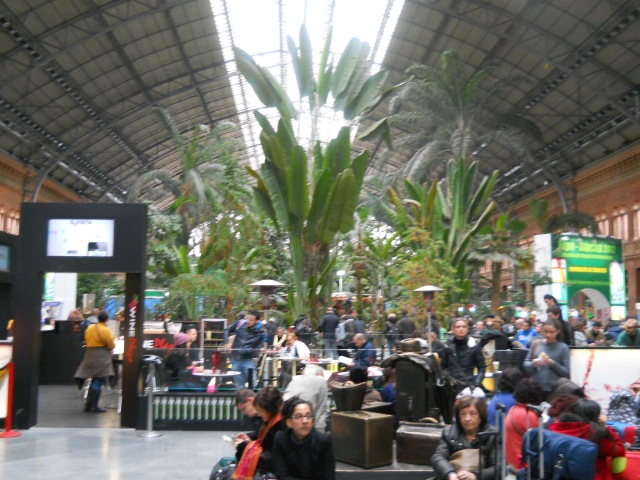
I was disappointed with Barcelona, but things were already looking up when we got off the L3 at Sants Station. Finding our way from the subway platform to the main station was not easy in a city with few signs and a fierce attachment to an obscure language, but we we weren’t left wanting for long: a little old lady sidled up to us, noticed our suitcases and gave us directions to the platform. I was prepared not to listen to yet another person pointlessly railing in Catalan, but to my astonishment I understood what she was saying– she was speaking Spanish. I thanked her and raced to the main concourse.
AVE is Spain’s high-speed rail system; the line from Barcelona to Madrid is one of their newest, and it is the second-fastest train in the world (the fastest is the LGV-Est in France). One look at a map of AVE makes you wonder how a flat-broke country like Spain can continue to build high-speed rail while America can’t. The United States’ only HSR line is the Acela, which runs from Boston to Washington via New York, Philadelphia and Baltimore. However, it runs on shared track and doesn’t go above 200 kilometers per hour (the Barcelona-Madrid line manages 300). Eight high-speed rail systems are in the planning phases across America, but while California is coming close to breaking ground on exclusive track, the rest are based on marginal improvements like concrete ties and grade separation. In 2011, Republican governors in Ohio, Wisconsin, and Florida actually shut down projects in their states to spite President Obama.
But I digress. Sants Station is in a hideous building, though my mom was spared the indignity of having to see the outside. Instead we waited. Across from us sat a young, pretty girl with fluffy brown hair, freckles, and a trademark Catalan nose. As far as my mom and I could tell, Catalan women all have short noses. She wore a colourful outfit and pulled out a massive book– a George R.R. Martin book, maybe. Accidentally, I had dropped the bottlecap from my coke between my mom’s seat and mine, and the girl gave me a judgmental look as I struggled to fish it out.
“She gave me a look,” I said to my mom.
“Who cares?” she said. “She’s reading a dictionary.”
Our laughter spun out of control, gathering further looks of disdain.
We arrived in Atocha Station, a place that I’d first heard of under unfortunate circumstances in the eighth grade, when Al Qaeda detonated several bombs on commuter trains here to commemorate 2 1/2 years since 9/11. That day in Spanish class we learned the phrase “¡Al Qaeda no pasajaron!”

In the cold we stumbed to Atocha’s 19th-century concourse, a glorious brick edifice with a glass roof and a massive indoor tropical garden. It was 13:00 as I raced to the nearest café, then to the bathroom, then back to the café. I ordered for both of us in my normal Spanish accent and the waitress didn’t even blink. It was in Madrid that I discovered I have a Castillian accent.
I’ve taken five years of Spanish lessons from teachers variously speaking in Andalusian, Mexican, Chilean and Venezuelan accents, but here in Madrid strangers spoke openly to me as if I were a local. Of course, being thin and wearing a tie helped; Spaniards are possibly the dressiest people in the world.
Even in Spanish I’m a posh spaz, I thought. Compared to Barcelona, this was like being at home. Madrid was going to be fun.